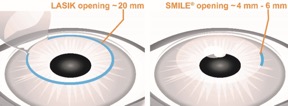The FDA approved the SMILE procedure in 2016 for the correction of myopia (nearsightedness) and astigmatism in the United States, but is has been is wide use in Europe since 2009. Worldwide over 2 million SMILE procedures have been performed. The SMILE procedure goes by several different names: ReLEX SMILE, SMILE LASIK, and Small Incision Lenticular Extraction.
SMILE Procedure
Refractive Eye Surgery
Refractive procedures use laser or intraocular lenses (IOLs, Phakic IOLs) to reduce the need for eye glasses. For example, myopia (near sightedness) is an eye disability where individuals cannot see distant objects without glasses.

This happens because their eye is too long or their cornea is too steep. SMILE, LASIK, and PRK are eye laser procedures that can correct this disability by flattening the cornea so that the eye can properly focus for far vision. LASIK, SMILE, and PRK are all fantastic ways to treat myopia and astigmatism. In fact, I had LASIK on my eyes 20 years ago and have loved it.
In this post I will focus on LASIK and SMILE ReLEX, the two rapid healing procedures. Let’s talk first about LASIK, then SMILE, and then compare the two procedures.
LASIK
With LASIK, a thin flap is created by a femtosecond laser. This flap is elevated and then an excimer laser is used to vaporize away a small lenticule of tissue. This flattens the cornea. The thicker the lenticule, the more myopia is treated. The flap is then repositioned and allowed to heal back in place. An average cornea would be around 540 microns thick. Another way to describe LASIK would be to consider it like a 540 page book. The top 110 pages are opened up like the first 110 pages of the book. Then the next 50 pages are removed and the first 110 pages are then closed back in place. The overall weakening would be 110 plus 50 or 160 pages of the total 540 page book. This leaves 380 pages untouched which is considerably more than enough remaining strength for good candidates.
Small Incision Lenticular Extraction
SMILE is an acronym. The SM is for Small. The I ins for Incision. The L is for Lenticular and the E is for Extraction. This acronym explains what SMILE is. The femtosecond laser creates a small lenticule inside the cornea. This lenticule is removed through a small incision which flattens the cornea. Using our book analogy, 50 pages of the total 540 pages are removed through a small opening so the overall weakening is approximately 50 pages of the 540 total pages.
LASIK vs SMILE ReLEX
Both procedures are outstanding for appropriate candidates and most patients could appropriately choose either and be pleased with their results.

Size of Your prescription:
For small prescriptions, LASIK is often better than SMILE. This is because in SMILE the lenticule needs to be strong enough to be grasped for removal through the small incision. In a small prescription, the lenticule may be too thin for removal.
Strength of Your Eye:
Most of the screening tests done before you have your laser eye surgery are to determine if you appear to have more than enough corneal strength to undergo laser eye surgery. If you are told you are not a candidate, it is usually because your surgeon fears that you do not have enough strength to handle the amount of correction you will need. This could mean you have a big prescription, a thin cornea, or evidence of a weaker than normal corneal. The goal is to end up with a cornea that can hold its strength and shape for the rest of your long and wonderful life.
The eye is stronger after SMILE than LASIK. The front part of the cornea (anterior) is the strongest part of the cornea. LASIK and SMILE both remove a thin lenticule of tissue from the weaker middle part of the cornea. This results in a minimal and inconsequential weakening in appropriate candidates.
Creating the LASIK flap cuts across the stronger anterior cornea for 320 degrees whereas SMILE leaves all but 60 degrees of this tougher anterior cornea untouched. Appropriate candidates for LASIK have more than enough strength reserve for this procedure, but all other factors being equal, the great biomechanical strength left by SMILE is compelling.1,2
Extreme Sports & Refractive Surgery
The LASIK flap is more susceptible to extreme trauma. SMILE does not have a flap, so could be preferred for patients that engage in extreme sports, martial arts, or for first responders who put their eyes in harm’s way.
Dry Eye and Refractive Surgery
Most patients sense an increase in dry eye symptoms after laser eye surgery for the first 3-6 months but then return to whatever was their preop baseline for dryness after they heal. Part of the reason this happens is because we disturb the nerves that sense dryness in the cornea and they need that amount of time to heal. Those nerves are most concentrated in the anterior part of the cornea and since LASIK transects those nerves for 320 degrees and SMILE for only 60 degrees we tend to see less dry eye after SMILE.3,4

Can the SMILE Procedure Correct Astigmatism?
Astigmatism means you eye is shaped more like an egg than a ball. This make images out of focus. Fortunately, refractive procedures like SMILE and LASIK treat astigmatism by returning your cornea to a more round shape so it can create a clearer focus. Smile is FDA approved to treat up to 3 diopters of astigmatism while LASIK can treat up to 5 diopters of astigmatism. Patients which astigmatism greater than 3 diopters are better served by LASIK.
Hyperopia (Far-Sightedness)
Around 10% of the population have hyperopia. LASIK can treat hyperopia but SMILE is not FDA approved to treat hyperopia.

SMILE LASIK
The accuracy results of LASIK and SMILE are equivalent for patients with normal prescriptions.5 LASIK has a greater ability to be customized for patients with non-standard prescriptions. Patients with non-standard shapes to their corneas or overall visual system may be better served by “topo guided” or “wavefront-guided” LASIK treatments than SMILE.
SMILE PROCEDURE Enhancements
Around 2-6% of patients need to have an enhancement procedure after LASIK or SMILE depending on their prescription. LASIK can generally be enhanced with LASIK or PRK. SMILE can also generally be enhanced with LASIK or PRK, but not SMILE.
Cost of the SMILE Procedure
There are several companies that make good femtosecond flap makers for LASIK. On the other hand, there is currently only one company, Zeiss, that makes an FDA approved femtosecond laser for SMILE. There are significant costs involved in obtaining this laser just so you can offer SMILE for those patients that will be benefitted by it. In that sense, SMILE should probably cost more than LASIK. At our clinic, we have decided to charge the same for LASIK and SMILE so that cost doesn’t enter into our patient’s decision about which procedure will be best for them.
How do I Decide Between the SMILE Procedure and LASIK?
The best way to decide between various laser vision correction options is to begin by studying information such as that listed above and then to consult with your optometrist to determine which surgeon in your region they recommend based on their results and how they care for their patients. Then set up a consultation with the recommended ophthalmologist and seek their opinion. They will be able to speak to the specific nature of your prescription and lifestyle needs and make a recommendation. Ideally, the surgeon you consult would have both SMILE and LASIK lasers to help remove any potential for bias and bring experience to their recommendations.
Gary Foster, MD is a SMILE procedure and LASIK surgeon in Northern Colorado and the medical director of The Eye and Laser Center of Northern Colorado, P.C.
The best way to decide between various laser vision correction options is to begin by studying information such as that listed above and then to consult with your optometrist to determine which surgeon in your region they recommend based on their results and how they care for their patients. Then set up a consultation with the recommended ophthalmologist and seek their opinion. They will be able to speak to the specific nature of your prescription and lifestyle needs and make a recommendation. Ideally, the surgeon you consult would have both SMILE and LASIK lasers to help remove any potential for bias and bring experience to their recommendations.
Gary Foster, MD is a SMILE procedure and LASIK surgeon in Northern Colorado and the medical director of The Eye and Laser Center of Northern Colorado, P.C.
- Wu D, Wang Y, Zhang L, Wei S, Tang X. Corneal biomechanical effects: small-incision lenticule extraction versus femtosecond laser-assisted laser in situ keratomileusis. J Cataract Refract Surg. 2014;40(6):954-962.
- Seven I, Vahdati A, Pedersen IB, et al. Contralateral eye comparison of SMILE and flap-based corneal refractive surgery: computational analysis of biomechanical impact. J Refract Surg. 2017;33:7:444-453.
- Denoyer A, Landman E, Trinh L, Faure JF, Auclin F, Baudouin C. Dry eye disease after refractive surgery: comparative outcomes of small incision lenticule extraction versus LASIK. Ophthalmology. 2015;122(4):669-676.
- Cai WT, Liu QY, Ren CD, et al. Dry eye and corneal sensitivity after small incision lenticule extraction and femtosecond laser-assisted in situ keratomileusis: a meta-analysis. Int J Ophthalmol. 2017;10(4):632-638.
- Sia RK, Ryan DS, Beydoun H, et al. Visual outcomes after SMILE from the first-year experience at a U.S. military refractive surgery center and comparison with PRK and LASIK outcomes. J Cataract Refract Surg. 2020;46(7):995-1002.
